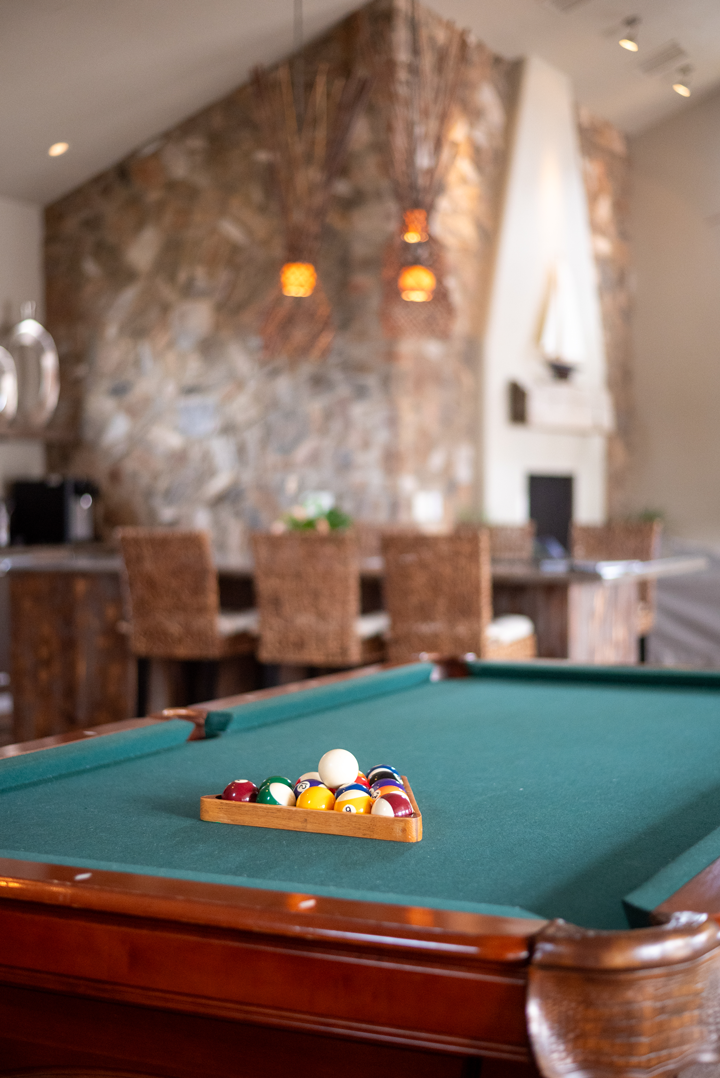When Anderson Souza moved back to Colorado from California, it wasn’t the sprawling, impressive home in a Fort Collins neighborhood that drew his eye. It was the home’s pool house.
“I loved the house, but for me it was the pool house that sealed the deal,” says Souza, a father to two children with his wife, Juriana Sperandio.
Souza immediately recognized it as a space that would make entertaining easy—a space that could be dedicated to fun, and one that would leave the main house and its inhabitants in peace. A perfect man cave.

Anderson Souza’s mountain modern man cave. Photo by Jordan Secher.
Reinventing the entertainment space
Souza represents many of today’s homebuyers who are looking for a space in their home that can be tailored to their interests. These spaces are not for frat-house couches and football jerseys; they are refined enough for guests but still dedicated to hobbies, television, games, sports and more.
“It used to be that the man cave was a space off in another part of the house,” says Kelly McBartlett, real estate broker with MCM Collective/Compass Real Estate. “Now we are seeing a desire for large, masculine entertaining spaces that can hold a bar, theater or wine room and that are more open to the rest of the home.”
These spaces are meant to be shown off, and Souza’s “man cave” is a terrific example. It features a pool table, ping-pong table, foosball table, large stone fireplace, TV area, steam room, loft and kitchen with all the bells and whistles (this writer’s favorite part is the stone island with a built-in ice reservoir for serving drinks).
“We do all our entertaining here,” he says. “It’s just so convenient. When you’re finished, everything is here. The party is self-contained.”
On a small scale, McBartlett says some of today’s man caves are formal living rooms that have been transformed into a space for shared company, minus the formal feel.
“It’s almost a harkening back to the ’50s and ’60s, with its parlor vibe, bar and cool artwork,” he says.
On a large scale, McBartlett recalls a client who built a 3,000-square-foot barn on his five-acre property that contained a chef’s kitchen, large hearth and enormous entertaining space. The homeowner loved to have guests over, while his wife preferred her privacy.
“People are more savvy with interior design,” says McBartlett, “and they are having better conversations about how to make compromises between couples.”

The 3,000-square-foot barn that belongs to one of Kelly McBartlett’s former clients. Photography by Boxwood Photos.
Design how-to
Emily Chase with Eheart Interior Solutions in Fort Collins first recommends considering the function and purpose of a room, then deciding on a look that works with that purpose. Three styles she finds popular today are dark academia, grandpa chic and mountain modern.
Dark academia features dark woods, traditional detailing and saturated paint in a rich, moody jewel tone from floor to ceiling. Chase lists shades of plum, burgundy and olive green as some favorite color choices. The furniture is reminiscent of collegiate libraries: nail head trim, lamp lighting, antique decor and “lots of stuff—rooms heavy with traditional items,” she says.
Grandpa chic, on the other hand, is more of a nod to the ’60s and ’70s, with plenty of leather and plaid as well as a healthy dose of mid-century modern design. “This is a style where you can introduce more variety in the furniture,” she says. “It’s a masculine version of grandma chic.” For those who are unfamiliar with grandma chic, the decor is known to be cozy yet stylish while incorporating vintage and eclectic pieces.
The final design style is one that Souza chose for his space: mountain modern. This style, according to Chase, is filled with natural woods, organic materials and dark metals, but in a way that doesn’t feel natural. It incorporates interesting textures and sleek elements alongside organic materials. It’s a design style that works best in spaces with plenty of room and natural light.
“This design style often appeals to
someone whose taste is more contemporary,” she says, “someone who likes less ornament and a sleeker environment.”
Chase cautions that well-designed spaces stay away from overly themed decor, such wall-to-wall golf paraphernalia. Her advice: Choose items that have more character, like a bowl of antique baseballs rather than lining the wall with mass-produced, sports-themed posters.
“Incorporate themes at a tasteful level,” she advises. “Don’t decorate with a theme if it isn’t relevant to the space.”

The 3,000-square-foot barn that belongs to one of Kelly McBartlett’s former clients. Photography by Boxwood Photos.
These types of spaces, which Chase says can be unashamedly about the TV or more focused on fun than the formal areas of the home, are great ways to repurpose rooms that are largely unused, such as a dining room, living room or office space.
Any function can be worked into a space that displays character and taste, Chase says. For example, a workout room can incorporate beautiful wall coverings and textures using materials that are still easy to clean.
“This is where a designer can really help,” she adds.







